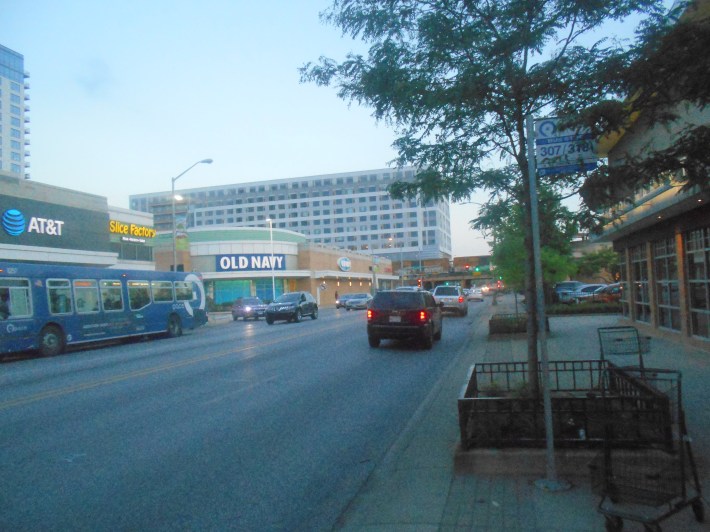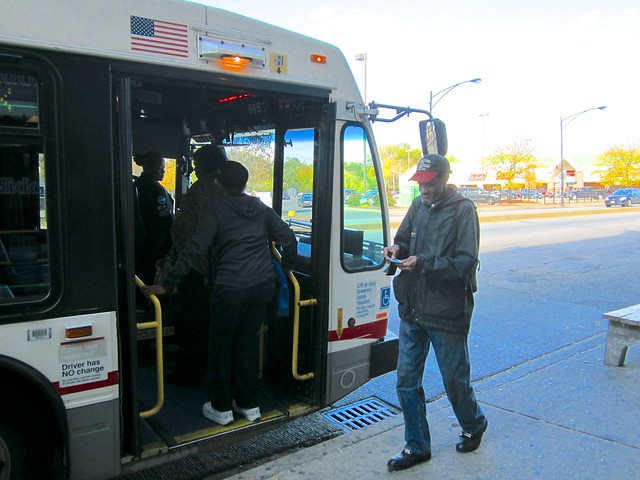Have you ever wondered how the CTA and Pace decide where to put bus stops?
It’s not a trivial question. CTA buses only stop at designated bus stops with signs. And Pace has been slowly but surely shifting in that direction as well, moving away from the existing flag stop scheme, where riders can flag down a bus at any intersection and get off at any intersection. And when you talk about CTA express buses and Pace’s upcoming Pulse "Arterial Rapid Transit" buses, which are supposed to make fewer stops than regular routes, the placement of the stops becomes that much more vital.
It says something about just how important bus spacing is that this year’s Transport Chicago conference, which brings together planners, researchers and transportation agencies, devoted an entire panel to the topic. Dimitris Nioras, an urban planner who recently interned at the Chicago Metropolitan Agency for Planning, found that reducing the number of stops didn’t necessarily reduce ridership -- although, paradoxically, it may have slowed down the express buses. And Pace officials explained that, when they are deciding where to place stops for the faster Pulse service along Harlem Avenue, they are focusing on transit connections first and foremost.
Bus Stop Spacing Study
Dimitris Nioras’s study looked at the consequences of the CTA’s decision to consolidate bus stops along Ashland Avenue -- specially on the more local #9 Ashland, from which the CTA removed about half the stops, and the express Route X9. He also looked at routes that largely paralleled that corridor - #8 Halsted, #50 Damen and Western Avenue’s #49 and #X49.
Nioras explained that normally CTA policy requires that local routes have stops every eighth of a mile and express routes have stops once half mile. For routes #9 and #49, the transit agency increased the gap to once every quarter mile. Nioras looked at the travel times and ridership for all six routes, and discovered some unexpected results. “For Western and Ashland [express] buses, the travel time actually increased,” Nioras said. “But we can also see that travel time decreased in local routes, which is interesting.”
Nioras also noted that the study showed that, while the ridership goes up and down during various times of the year, overall, it stayed within the same range and followed the same general pattern for all six routes except the #8, which saw a noticeable uptick in passengers in the last two quarters of 2018. He said that overall this suggests that reducing bus stops has no impact on ridership, so the CTA should feel comfortable spacing the stops wider. At the same time, he noted that more space between bus stops causes longer dwell times as buses wait for more passengers to board, and spacing the bus stops too far apart would cause inconvenience for riders. “Stop spacing should be based on a balanced compromise of speed and coverage,” Nioras said.

Central Harlem Corridor Study
Meanwhile, in the west suburbs, Pace is currently working to launch Pulse Arterial Rapid Transit bus routes along several of its major corridor. The concept has certain similarities to bus rapid transit, with station-like stops that are spaced further apart than regular routes and specialized buses. But unlike BRT, they don’t have dedicated bus lanes or prepaid boarding, though they do get signal priority at certain intersections. Pace recently announced that it’s launching the first Pulse route on Milwaukee Avenue on August 11, and it’s actively planning the Dempster Street and 95th Street routes.
The Harlem Avenue corridor is a bit further down the line of priorities. Current plans call for the service to run between North Avenue and 95th Street. While other Pulse routes follow existing Pace lines, Harlem Pulse would stand out because it would actually follow two regular routes, Route 307 between North Avenue and 71st Street and Route 386 the rest of the way.
Pace recently completed the study that mostly tackled that first portion. During the panel, Michael Groh, a transit planner for Sam Schwartz Engineering consulting firm, focused on the transit access improvements and stop spacing aspects of the study.
He said that, when choosing the stop locations, they looked at demographics, land use, what kind of transit options are already there, as well as general walkability and bikeability. They also looked at how far apart the stops were and whether they would provide good links with other Pace and CTA bus routes. “We also wanted this service to work as part of a network and those connections are important,” Groh said.
In the end, the study suggested 11 high-priority stations, seven medium-priority stations and four low-priority stations. Because of the factors Groh outlined, the spacing between high-priority stations isn’t always consistent, but most of them are positioned at ‘L’ and Metra stations, as well as intersections that have at least one other bus route. The stops that were located at major street corridors that didn’t have any transfers tended to get medium priority or lower. One major exception to that trend is the stop at Stevenson Expressway, which is the closest stop to Summit Metra and Amtrak station. While it is close, it isn’t directly at the station, and that station gets less frequent service than other Metra and ‘L’ stations along Harlem Avenue.
If one assumes that Pace will put in both high-priority and medium-priority stations, some of the gaps aren’t quite as dramatic, though the spacing still isn’t consistent. Groh said that, when it came to narrowing down exactly where along the intersections the bus stops would go, they looked at proximity to businesses and available rights of way. “This is where our interviews with community stakeholders came into play,” he said. “They provided very important guidance.”





